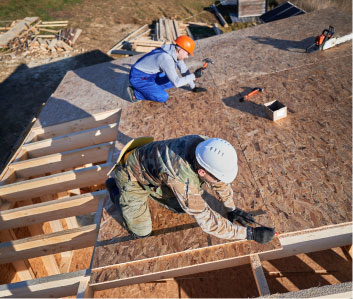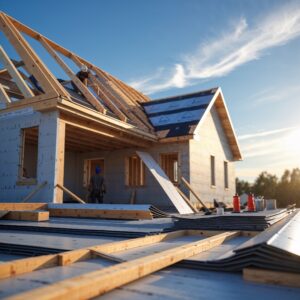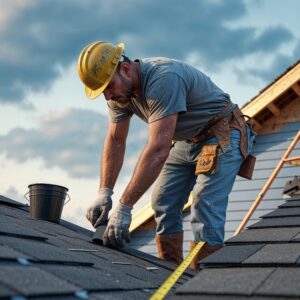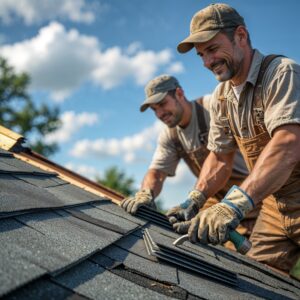On average, a roof in UK may last for 20 years before raising a need for replacement. But it highly depends on the materials you choose and the local climatic conditions you live in. Whenever you notice signs of damage to your roof, multiple holes in the structure and experience leaks, it means your roof integrity is compromised and demands replacement.
Homeowners face specific challenges due to the area’s coastal climate. Frequent exposure to humidity and heavy storms increases 37% the chances of early deterioration of roofing materials before the expected roof age. Therefore, residents must perform yearly inspections for timely detection, especially after 10 years, as your roof often needs to be replaced before 20 if not properly installed or maintained.
When should you worry about your roof?Replacing your roof before it fails helps you avoid costly damage to your home. Identify early signs of the need for a new roof and do it as soon as you can with proper consultation of Norwich roof contractors. Choose the right time, late spring or early fall, to keep your home safe from coming extreme conditions.
|
Factors Affecting the Roof Replacement Timelines
Various factors can contribute to damage to your roof structure and could affect its average lifespan, which always raises the question of how often residents should replace roofs in the UK. Regardless of the UK’s climatic conditions, every roofing material can withstand at least 15 to 20 years if professionally cared for. This life expectancy varies and depends on the multiple factors to be considered beforehand.
Local Climatic Conditions could Reduce the Roof Life Expectancy
UK’s unique weather and environmental conditions make it essential for homeowners to stay vigilant about how often they should replace a roof to stay safe and protected. It experiences a humid subtropical climate, leading to high moisture and substantial rainfall, which can cause frequent leaks and damage. High winds and storms can lift or completely remove the shingles and exacerbate the issues. This contributes to accelerated wear and tear of the roofing material, prompting the residents to consider roof replacement sooner than the average time.
Statistics show that 33% of homeowners need to replace their existing roofs due to storm damage, highlighting the climatic impact on the roofing structure.
Lifespan of Major Roofing Materials to Increase Replacement Time
Roofing materials have different life expectancy figures. Each will experience wear down over time, which makes it important to know when to replace it. You should consider the roof age to be 5 years less than the average due to the harsh weather conditions. But this isn’t always true if you keep it clean, inspect it thoroughly, and fix problems in a timely manner.
Knowing the lifespan of commonly used roofing material will help you estimate when you might need to replace your roof.
Asphalt Shingles— Replace After 20 to 30 years
As a popular choice for roofing, asphalt shingles can pass your 15 to 20 years easily without worrying about replacement. But this time, the figure varies according to its types.
It comes in three versions, such as:
- Three-tab— These are the most basic and economical options. They feature a flat, uniform appearance with cutouts that create the illusion of individual shingles. Three-tab asphalt has a lifespan of 20-25 years, but with Uk’s weather, where humidity is mostly at a peak, its longevity can be reduced to 10 years due to prolonged exposure to high winds.
- Architectural— They consist of multiple layers of asphalt, which are laminated together. This layered design provides a three-dimensional appearance and enhances the durability of weather compared to traditional three-tab shingles. Architectural asphalt has a standard life of 30 years, but with optimal conditions like favourable weather and high-quality maintenance, it can last longer, up to 50 years.
- Luxury—This type is considered premium not just in design but also in its high durability and resistance to various weather conditions. Luxury asphalt is the high-end roofing option for homeowners as it features advanced materials to resist storm and water damage. They typically come with warranties of 30 to 40 years, with some models lasting up to 50+ years under optimal conditions.
| Case Studies
Last year, our roof experts installed an architectural asphalt shingle roof in one of the houses to replace a three-tab. The homeowner told us he chose this material because of its affordability and 20-year lifespan when constructing his house in 2011. Despite regular maintenance, he began noticing signs of wear, like granule loss and water stains on different shingles, in just 12 years. Last season, due to heavy storming, two of the tiles even dislodged. On recommendation, he consulted with us to evaluate the condition of his roof. After a thorough inspection, our roofing professional confirmed that his roof had reached the end of its lifespan and advised him to replace it with Norfolk’s weather-durable material. At the end of 2023, he cooperated with us to install a high-quality architectural asphalt shingle roof. This not only improved insulation but proved energy-efficient for his house. This experience highlights the importance of timely roof replacement in Norfolk’s challenging climate. |
Metal Roofs— Replace After 40 to 70 years
Metal roofing is highly durable and energy efficient. It can withstand winds up to 165 mph, which is crucial during storms in the area. Metal roofs are also designed with snow-shedding capabilities and resist moisture from seeping into the structure, causing leaks or mould growth.
Despite all, the county’s proximity to saltwater can prone metal roofs to corrosion and heavy storming can cause minor dents. But this can be prevented by several protective roof coatings, which can delay the need for roof replacement for several decades.
Another important consideration is the type of metal you use in roofing, as every metal varies in condition for when it needs to be replaced.
| Metal Type | Life Span | Properties |
| Steel | 30-50 years | Withstand high winds |
| Aluminium | 40 to 70 years | Naturally resistant to rust |
| Copper | 100+ years | Highly durable for outside elements |
| Zinc | 80-100 years or even longer | Corrosion-resistant and self-heal minor scratches |
Wood Shakes and Shingles— Replace After 30 to 50 years
In the UK’s atmosphere, wood roofing can deteriorate early due to high humidity and moss growth. While cedar shakes can last up to 50 years and shingles typically span around 20 to 30 years, the moisture in the local environment and improper treatments for rot and mould can degrade it earlier. This may cause the replacement of wood roofs before the expected life.
Clay and Concrete tiles— Replace After 75 to 100 years
Naturally made clay and concrete tiles provide excellent durability and aesthetic appeal for homeowners. These stone roofs can withstand the region’s heavy moisture rate and extreme stormy winds but may require proper installation. By using clay roofing, you can spend several decades without worrying about replacing the roof. They have a high up-front cost, but their warranty of more than 75 years can make them a cost-effective choice to install.
Slate Roofs— Replace After 100 to 150 years
Incredibly durable and stays prolonged in areas. Slate roofs are naturally water-resistant and can withstand heavy rainfall without getting any damage. They are warranted to be effective for a century, and some high-quality slate can last even longer up to 200 years.
The quality of the slate itself tells when it should be replaced, but proper installation by experienced roof contractors is also required to ensure the benefits it offers.
Regular Maintenance to Avoid Common Repairing Issues
Your roof plays a vital role in keeping your home safe and comfortable. Yet many homeowners overlook its maintenance until significant problems arise. To prevent frequent replacement needs, it is important to inspect your roof on a yearly basis and seek professional roof cleaning and repair services.
Your roof is highly prone to debris buildup due to stormy breezes. This can cause drain blockages and water ponding, significantly damaging structural integrity. How often you should replace your roof depends on your prompt action against fixing these minor issues and routine checks for cracks or missed shingles, mainly after extreme weather.
Schedule your yearly roof inspection with the best roofer in Norwich now for a healthy and protective living!
How should you avoid early roof replacement?Heavy rainfall, high winds and the occasional snow in Norfolk can wear down your roofing materials faster than in other regions. To avoid this:
|
Conclusion
The frequency of roof replacement in the UK, depends on climate impact and the durability of the material you choose. Proactive measures can prolong the life expectancy of your roof, but generally, all materials can last up to 20 years except three-tab shingles. Homeowners must understand the expected lifespan of different roofing materials before installing and factors that could affect them to save costly emergency replacements.




